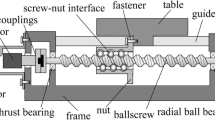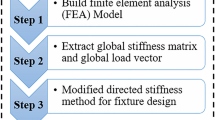Abstract
In the milling process, the coupling deflection and the dynamic characteristics of the cutter–workpiece system are time variant as the material removal and the change of cutter position. The milling stability of the system is dynamic because of the time-varying stiffness. In this study, the model of time-varying system has been developed. Variable pitch cutter (VPC) and variable spindle speed (VSS) are, respectively, typical method of passive control and active control to suppress the chatter, and two methods are compatible. The arithmetic of VPC and VSS combined method has been developed and verified effectively. Dynamic milling stability prediction of stiffness time-varying system for thin-walled components based on VPC and VSS combined method has been developed. And then, the dynamic milling stability of stiffness time-varying system for thin-walled components has been predicted.






Similar content being viewed by others
Abbreviations
- a e :
-
Nominal radial depth of cutting (mm)
- B 0 :
-
Initial thickness of workpiece (mm)
- d t :
-
Deflection of cutter (mm)
- d w :
-
Deflection of workpiece (mm)
- d c :
-
Coupling deflection of cutter–workpiece system (mm)
- N :
-
Sum of nodes on contact location of cutter and workpiece
- G y :
-
Relativity frequency response function of cutter–workpiece system in y-direction (mm/N)
- G y(t) :
-
Frequency response function of cutter in y-direction (mm/N)
- G y(w) :
-
Frequency response function of workpiece in y-direction (mm/N)
- δ y(t) :
-
Displacement of cutter in y-direction (mm)
- δ y(w) :
-
Displacement of workpiece in y-direction (mm)
- N c :
-
Number of teeth
- Δψ :
-
Pitch increment (°)
- ψ 0 :
-
Basic pitch variation (°)
- η :
-
Initial phase angle (°)
- Ω0 :
-
Nominal spindle speed value (r/min)
- T :
-
Time period (s)
- a p :
-
Axial depth of cutting (mm)
- hj(t):
-
Chip thickness (mm)
- k t :
-
Cutting force coefficient in tangential direction (N/m2)
- k r :
-
Cutting force coefficient in radial direction (N/m2)
- q :
-
Cutting force exponent
- ϕ st :
-
Start angle (°)
- ϕ ex :
-
Exit angle (°)
- f z :
-
Mean feed per tooth (mm/tooth)
- m :
-
Modal mass (kg)
- c :
-
Damping coefficient (N s/m)
- k :
-
Modal stiffness (N/mm)
- ξ :
-
Damping ratio
- ω n :
-
Natural frequency (Hz)
References
Bravo U, Altuzarra O, Lacalle LNL (2005) Stability limits of milling considering the flexibility of the workpiece and the machine. Int J Mach Tools Manuf 45:1669–1680
Herranz S, Campa FJ, Lacalle LNL (2005) The milling of airframe components with low rigidity. Proc IMechE 219:789–801
Schmitz T, Burns T, Ziegert J, Dutterer B, Winfough WR (2004) Tool length-dependent stability surfaces. Min Sci Technol 8:377–397
Song QH, Xing A, Tang WX (2011) Prediction of simultaneous dynamic stability limit of time–variable parameters system in thin-walled workpiece high-speed milling processes. J Adv Manuf Technol 55:883–889
Kurata Y, Merdol SD, Altintas Y, Suzuki N, Shamoto E (2010) Chatter stability in turning and milling with in process identified process damping. J Adv Mech Des Syst 4(6):1107–1118
Sofuoglu MA (2019) Prediction of stable depth of cuts in turning and milling operations: a new probabilistic approach. J Braz Soc Mech Sci 41(5):206
Slavicek J (1965) The effect of irregular tooth pitch on stability of milling. In: Proceedings of the 6th MTDR conference, London
Altintas Y, Engin S, Budak E (1999) Analytical stability prediction and design of variable pitch cutters. J Manuf Sci E-T ASME 121:173–179
Budak E (2003) An analytical design method for milling cutters with non-constant pitch to increase stability, part 1: theory. J Manuf Sci E-T ASME 125:29–34
Budak E (2003) An analytical design method for milling cutters with non-constant pitch to increase stability, part 2: application. J Manuf Sci E-T ASME 125:35–38
Sims N, Mann B, Huyanan S (2008) Analytical prediction of chatter stability for variable pitch and variable helix milling tools. J Sound Vib 317:664–686
Jin G, Zhang Q, Hao S, Xie Q (2014) Stability prediction of milling process with variable pitch and variable helix cutters. Proc Inst Mech Eng C J Mech Eng Sci 228(2):281–293
Jin G, Zhang Q, Hao S, Xie Q (2013) Stability prediction of milling process with variable pitch cutter. Math Probl Eng 2013(2):87–118
Stepan G, Munoa J, Insperger T, Surico M, Bachrathy D, Dombovari Z (2014) Cylindrical milling tools: comparative real case study for process stability. CIRP Ann Manuf Technol 63(1):385–388
Jin G, Zhang Q, Qi HJ, Yan B (2014) A frequency-domain solution for efficiently predicting stability of variable helix cutters milling. Proc Inst Mech Eng C J Mech Eng Sci 228(15):2702–2710
Sims ND (2016) Fast chatter stability prediction for variable helix milling tools. Proc Inst Mech Eng C J Mech Eng Sci 230(1):133–144
Guo Q, Jiang Y, Zhao B, Ming P (2016) Chatter modeling and stability lobes predicting for non-uniform helix tools. Int J Adv Manuf Technol 87(4):251–266
Takemura T, Kitamura T, Hoshi T (1975) Activesuppression of chatter by programed variation of spindle speed. Int J Jpn Soc Precis Eng 41(484):489–494
Zatarain M, Bediaga I, Munoa J, Lizarralde R (2008) Stability of milling processes with continuous spindle speed variation: analysis in the frequency and time domains, and experimental correlation. CIRP Ann Manuf Technol 57(1):379–384
Seguy S, Insperger T, Arnaud L, Dessein G, Peign G (2010) On the stability of high-speed milling with spindle speed variation. Int J Adv Manuf Technol 48(9–12):883–895
Xie Q, Zhang Q (2012) Stability predictions of milling with variable spindle speed using an improved semi-discretization method. Math Comput Simul 85(3):78–89
Totis G, Albertelli P, Sortino M, Monno M (2014) Efficient evaluation of process stability in milling with spindle speed variation by using the Chebyshev collocation method. J Sound Vib 333(3):646–668
Niu J, Ding Y, Zhu LM, Ding H (2016) Stability analysis of milling processes with periodic spindle speed variation via the variable-step numerical integration method. J Manuf Sci E-T ASME 138(11):114501-1-11
Bravo U, Altuzarra O, Lopez de Lacalle LNL, Sanchez JA, Campa FJ (2005) Stability limits of milling considering the flexibility of the workpiece and the machine. Int J Mach Tool Manu 45(15):1669–1680
Thom B, Imran K, Tim M, Elaine L, Nico V, Dennis J (2017) A combined experimental and finite element approach to analyse the fretting mechanism of the head-stem taper junction in total hip replacement. Proc Inst Mech Eng H 231(9):862–870
Jin G, Qi HJ, Li ZJ, Han JX (2018) Dynamic modeling and stability analysis for the combined milling system with variable pitch cutter and spindle speed variation. Commun Nonlinear Sci Numer Simulat 63:38–56
Insperger T, Stepan G (2011) Semi-discretization for time-delay systems stability and engineering applications. Applied mathematical sciences, 1st edn. Springer, New York
Zhang L, Gao WG, Zhang DW, Tian YL (2016) Prediction of dynamic milling stability considering time variation of deflection and dynamic characteristics in thin-walled component milling process. SHOCK VIB 2016:1–14
Jin G, Qi HJ, Cai YJ, Zhang QC (2016) Stability prediction for milling process with multiple delays using an improved semi-discretization method. Math Methods Appl Sci 39(4):949–958
Zhang L, Ma LJ, Zhang DW (2018) Dynamic milling stability of thin-walled component considering time variation of coupling deflection and dynamic characteristics of tool-workpiece system. Int J Adv Manuf Technol 94:3005–3016
Acknowledgements
This work was supported by the National Natural Science Foundation of China (Grant No. 51905082), the Fundamental Research Funds for the Central Universities (Grant No. N2023024), Scientific Research Initiation Funds for Northeastern University at Qinhuangdao (Grand No. XNY201807), and National Defense Key Funds for Equipment Pre-research (Grant No. 61409230103).
Author information
Authors and Affiliations
Corresponding author
Additional information
Technical Editor: Adriano Fagali de Souza.
Publisher's Note
Springer Nature remains neutral with regard to jurisdictional claims in published maps and institutional affiliations.
Rights and permissions
About this article
Cite this article
Zhang, L., Hao, B., Xu, D. et al. Dynamic milling stability prediction of thin-walled components based on VPC and VSS combined method. J Braz. Soc. Mech. Sci. Eng. 42, 336 (2020). https://doi.org/10.1007/s40430-020-02419-x
Received:
Accepted:
Published:
DOI: https://doi.org/10.1007/s40430-020-02419-x




